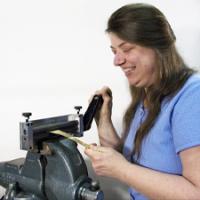Raising a Vessel
Experience the magic of using a hammer to transform a flat disc of metal into an elegant bowl, cup, or vase, while learning to let the hammer "do the work", improving endurance and accuracy during the hammering process. During this workshop, students will explore sinking, crimp raising, angle raising, and planishing techniques.
Students will also learn a few techniques to set the bottom of their vessels and ways to finish the edge or "lip". Beginners will be encouraged to raise a symmetrical piece from a round disc. Experienced students may choose to start metal a different shape and raise an asymmetrical vessel.
Meet the instructor

Whether using hammers and stakes, or hydraulic press tools, Cynthia's sculptural jewelry and hollowware shows her focus on exploring the fluidity with which metal can be moved, formed, and joined.
Cynthia Eid co-authored the book Creative Metal Forming, with Betty Helen Longhi, published in 2013 by Tim McCreight's Brynmorgen Press. In his foreword for the book, Michael Good says the authors "have succeeded in assembling the first comprehensive textbook on synclastic and anticlastic forming." (More about the book available at www.creativemetalforming.com.)
Cynthia and Betty developed a set of anticlastic stakes, and Eid also works with Knew Concepts and Bonny Doon to help make tools for jewelers and metalsmiths. Lee Marshall has dubbed Cynthia Eid "Godmother of the Knew Concept Saws" since it was her idea for him to produce these saws for jewelers.
Excited about working in sterling silver without the problem of firescale, Cynthia has been working with Argentium Silver since 1999. After meeting Peter Johns (the inventor of Argentium Silver) in 2003, Eid has participated in AS's development. Argentium International, Ltd recognizes her as a Pioneer.
Cynthia Eid's metalwork has won awards for creativity and design, been featured in many publications, and been exhibited internationally. With a BS in Art Education and MFA in Jewelry, Design, and Silversmithing, she has previously worked as a bench jeweler for fine goldsmiths, a model-maker in a gold jewelry factory, and on private commissions. Her work is in museums in the US and UK. Currently an independent metalsmith and educator, she teaches weekly classes at Metalwerx in Massachusetts, and workshops and short courses in the US, Canada, Europe, and Australia.
Materials & Tools
- 6" to 8" disc of 18g/1mm thick copper - for beginners
- Consider buying two 6” discs as some students have time to make two 6” bowls.)
- Experienced students may choose to work larger (8" to 9”) and/or asymmetrically in copper, traditional sterling, Argentium silver, bronze, red brass or Nugold.
- Yellow brass, nickel silver, pewter, aluminum, and titanium are amongst the metals that are either too hard or too soft for this workshop.
- unlined paper and pencil
- “Extra Fine” Sharpie marker
- Students should always wear closed toed shoes in the studio.
Metalwerx has tools and equipment for students to use, but you may need to share and condition of the tool may not be perfect. The following items are all optional but recommended if you have them already.
- hammers and stakes that you have, such as raising, forming, and planishing
- 6" file - #2 and/or #0 cut
- compass (Amazon or Steve Shelby)
- Some people like to wear a pair of well-fitting gloves to improve grip on metal and hammer, and to reduce vibrations. These can be leather gloves or plastic gardening gloves.
- Some people like to wear ear plugs.




